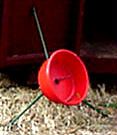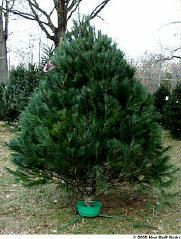Taking Care of Your Tree
Once you get your tree home, you will need to do a few things to keep it fresh. With proper care, the average fresh Christmas tree should last at least five to six weeks. In fact, last year, one of the staff here at HowStuffWorks wanted to see just how long she could keep her tree up. She finally had to take it down as a birthday present to her husband -- on February 8! While we don't recommend this, it's neat to know that a tree can last that long.
The main thing your tree needs is water. You've probably heard of several home remedies that suggest you add something to the water, such as aspirin, 7UP or Sprite or even bleach! You don't need to do that. Plain water will do just fine.
Advertisement
Once you bring your tree home, if you are not going to set it up immediately, you should put it in a bucket of water in a well-shaded area out of the wind. Most retail locations will put a fresh cut on the tree -- trimming about one-fourth to one-half of an inch (0.64 to 1.25 cm) from the base. It can take as little as four to six hours for the base of the tree to sap over. When this happens, a seal is formed and the tree will no longer take water. If this does happen, you can make another fresh cut and place it in water immediately.

You can trim your tree even after you have put it in a stand. You can cut back some of the bark along the base, exposing the pinkish layer underneath, or you can drill a few shallow holes along the base. This works because it is not the center of the trunk, which absorbs the majority of water, but rather the outermost rings just below the bark.
One of the easiest ways to make sure your tree is getting enough water is to select the best tree stand. The average Christmas tree can use as much as 1 gallon (3.79 liters) of water a day, and you should check the water level daily. The general rule of thumb, according to the National Christmas Tree Association, is that one quart (0.95 liters) of water is required for each inch (2.54 cm) of the trunk's diameter. So, if you have a tree that is about 6 feet (1.83 meters) tall with a trunk that measures about 4 inches (10 cm) in diameter, you will need to have a stand that holds at least 1 gallon (3.79 liters) of water.
When shopping for stands, be sure to find out how much water the stand holds when a tree is placed in it. Many simply tell you how much water the stand holds without taking into account the displacement that occurs once the tree is in the stand. The stands shown below are examples of really great stands.
In addition to keeping your tree watered, you should not place your tree near anything that could be a possible heat source. Avoid fireplaces, furnaces and air vents.
It's really amazing that something that starts out the height of a quarter turns into a big, beautiful centerpiece for the holiday season. Please remember that when the season is over, you should remove your tree before it dries out. Several communities recycle trees by chipping them -- check with someone in your area about this service.
In the next section, we'll look at some alternative choices to organic Christmas trees.
